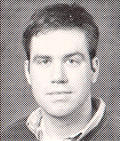
Adam Johnson
Thesis Title:
On the use of cognitive maps
Current Position:
Adjunct Assistant Professor, Department of Psychological and Brain Sciences, Boston University
Assistant Professor, Psychology Department, Bethel University
Undergraduate Institution and Major/Degree:
- Minnesota State University-Mankato, Physics, Psychology, 2002
Major Advisor(s):
A. David Redish, Ph.D.
Research Description:
What does a memory look like? What would it look like in the brain?
D.O. Hebb postulated that memory is a modulation of sensory experience.
Activity within neural populations results from a combination of sensory input and internal dynamics. In some circumstances, sensory input primarily drives the activity. In other circumstances, activity within a population tumbles forward based on its own internal dynamics. This forward tumbling results in activities that progressively deviate from and modulate sensory inputs. Such deviations, Hebb argued, provide a basis for attention, memory, and imagination.
The hippocampus is a brain area that supports functions as diverse as episodic memory in humans and spatial navigation in animals. Hippocampal pyramidal cells display activities associated with an animal’s position in space – they spike in small areas of an animal’s environment that is sometimes called a place field. From the activity of these cells we can predict where an animal is within its environment. More interestingly, these activities sometimes lead to predictions that diverge from the animal’s current position. Although these predictions do not match the animal’s current behavior, they are related to the animal’s future spatial behavior, much as Hebb might have predicted. My thesis work focuses on how these spatial representations within the hippocampus and associated cortical areas transition between current sensory driven input and memory function and contribute to decision-making. My research combines behavioral and electrophysiology experiments and theoretical modeling and analysis.
Lab Rotations:
- James Ashe
- A. David Redish
- Dan Kersten
- Steven Strother
Courses Taken Beyond the Core Courses:
- Computational and Theoretical Neuroscience I and II (Nsc 5101, 5102)
- Math Methods for Human Behavior (Psy5018)
- Theory of Statistics I (Stat5101)
Graduate Level Minor:
- supporting coursework
Conferences Attended:
- Society for Neuroscience annual meeting – 2002-2006
- Computational Neuroscience annual meeting – 2005-2006
- Computational and Systems Neuro. (CoSyNe) annual meeting – 2007
- European Brain and Behavior Society annual meeting – 2005
- Okinawa Computational Neuroscience Course - 2004
Committee Members:
- James Ashe
- Paul Schrater
- Jonathan Gewirtz
- A. David Redish (chair)
Selected Publications and Presentations:
- van der Meer MA, Johnson A, Schmitzer-Torbert NC, Redish AD. Triple dissociation of information processing in dorsal striatum, ventral striatum, and hippocampus on a learned spatial decision task. Neuron. 2010;67(1):25-32.
- Johnson A, Fenton AA, Kentros C, Redish AD. Looking for cognition in the structure within the noise. Trends Cogn Sci. 2009 Feb;13(2):55-64.
- Redish AD, Jensen S, Johnson A. A unified theory of addiction: vulnerabilities in the decision process. Behav Brain Sci. 2008;31(4):415-37;
- Johnson A, van der Meer MA, Redish AD. Integrating hippocampus and striatum in decision-making. Curr Opin Neurobiol. 2007;17(6):692-7.
- Johnson A, Redish AD. Neural ensembles in CA3 transiently encode paths forward of the animal at a decision point: a possible mechanism for the consideration of alternatives. J Neurosci. 2007;27(45):12176-89.
- Redish AD, Jensen S, Johnson A, Kurth-Nelson Z. Reconciling temporal-difference models with the behavioral extinction and renewal: implications for addiction, relapse, and problem gambling. Psychol Rev. 2007;114(3):784-805.
- Redish AD, Johnson A. A computational model of craving and obsession. Ann N Y Acad Sci. 2007;1104:324-39.
- Jackson JC, Johnson A, Redish AD. Hippocampal sharp waves and reactivation during awake states depend on repeated sequential experience . J Neurosci. 2006;26(48):12415-26.
- Johnson A, Redish AD. Hippocampal replay contributes to within session learning in a temporal difference reinforcement learning model. Neural Netw. 2005;18(9):1163-71.
- Johnson A, Seeland K, Redish AD. Reconstruction of the postsubiculum head direction signal from neural ensembles. Hippocampus 2005;15(1): 86-96.
Book Chapters:
- Johnson A, Jackson JC, Redish AD. Measuring distributed properties of neural representation beyond the decoding of local variables – implications for cognition. chapter in Holscher C., Munk, eds. Mechanisms of information processing in the Brain: Encoding of information in neural populations and networks. Cambridge University Press, Cambridge UK, 2007; pp. 95-119.
Lectures:
- “Dynamic representations in the hippocampus: implications for navigation and memory.” Cosyne workshop on Hippocampus and Entorhinal Cortex, February 2007.
- “What’s that rat thinking? Information processing in the brain.” 3M TechForum Special Lecture – Life Sciences, Statistics and Modeling chapters, October 2005.
Awards and Honors:
- 2007 Beatrice Z. Milne and Theodore Brandenburg Award for Research in
the Basic Sciences, Minnesota Medical Foundation, University of Minnesota. - 2006 Stark Award, Graduate Program in Neuroscience, University of Minnesota.
- 2006-2007 Fulbright scholarship.
- 2006 Charles and Dorothy Andrew Bird Award, Sigma Xi.
- 2004-2006 Pre-doctoral fellowship, Center for Cognitive Sciences,
University of Minnesota. - 2002-2006 3M Graduate fellowship.
- 2002-2004 Pre-doctoral fellowship, IGERT Computational Neuroscience
Training Program, University of Minnesota. - 2002-2003 University of Minnesota Graduate Fellowship.
- 2002 William Rucker Award for Excellence in Psychology, Psychology
Department, Minnesota State University – Mankato. - 2001-2002 Independent Undergraduate Research Grant, Minnesota State
University – Mankato. - 2001-2002 College of Science Engineering and Technology General
Scholarship, Minnesota State University – Mankato. - 2001-2002 Wissink Scholarship, Physics Department, Minnesota State
University – Mankato. - 2000-2001 Wissink Scholarship, Physics Department, Minnesota State
University – Mankato.
Professional Memberships:
- Society for Neuroscience
- Sigma Xi
Home Town:
- Mankato, MN
